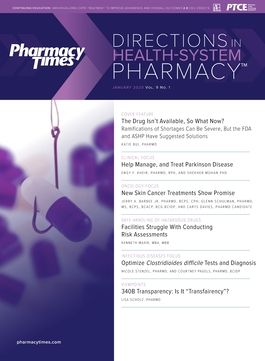Publication
Article
Pharmacy Practice in Focus: Health Systems
New Skin Cancer Treatments Show Promise
Author(s):
Advances in research and immunotherapy have led to breakthroughs regarding biologics targeting melanoma.
An estimated 96,000 cases of melanoma were diagnosed in 2019, and 7230 deaths were attributed to this type of cancer, based on statistics from the National Cancer Institute.1
The 5-year overall survival rate for melanoma is high, because 83.6% of cases are diagnosed early, at the local stage (Figure 1).1 However, this percentage drastically decreases once the cancer has metastasized (Figure 2).1
Melanoma arises when melanocytes, the cells responsible for producing melanin that provides pigmentation of the skin, become cancerous and create a malignant tumor.2
Advanced melanoma is classified as melanoma that has escalated beyond the point of the primary tumor in the body, according to the Skin Cancer Foundation.3
This classification encompasses stage III and IV cancers, which are diagnosed by physicians based on the tumor, node, and metastasis system.3,4 Typically, these advanced stages of melanoma involve the tumor spreading regionally to the lymph nodes (stage III) or metastasizing to other organs (stage IV) and can be further classified within each stage based on the characteristics of the tumor(s).2
Treatment Strategies
There are 5 standard treatment options for melanoma: chemotherapy, immunotherapy, radiation therapy, surgery, and targeted therapy.2 Most patients will receive a combination of these treatment modalities. 2,5As melanoma advances in stage, the treatment approaches will usually involve systemic therapy to target cells in various locations of the body.5
Targeted therapy involves BRAF and MEK inhibitors, which are personalized treatment options designed to aim for a specific defective gene in the body contributing to melanoma. BRAF is a gene that when functioning normally, regulates cell multiplication.3 Mutations affecting this gene can lead to continuous cell growth. BRAF mutations are found in about 50% of advanced melanoma cases and should be tested for in all patients with a confirmed diagnosis of advanced melanoma.3 BRAF and MEK inhibitors work by interrupting abnormal cell growth. When used alone, BRAF inhibitors are initially very effective in blocking the overproduction of cells, but then the tumor(s) typically develops resistance to the treatment. To combat this issue, an MEK inhibitor should also be administered in combination with a BRAF inhibitor to prevent the disease from advancing.3 However, in order
for personalized cancer treatment to be effective, the patient’s melanoma must carry the BRAF mutation targeted by these medications (Table 1).3
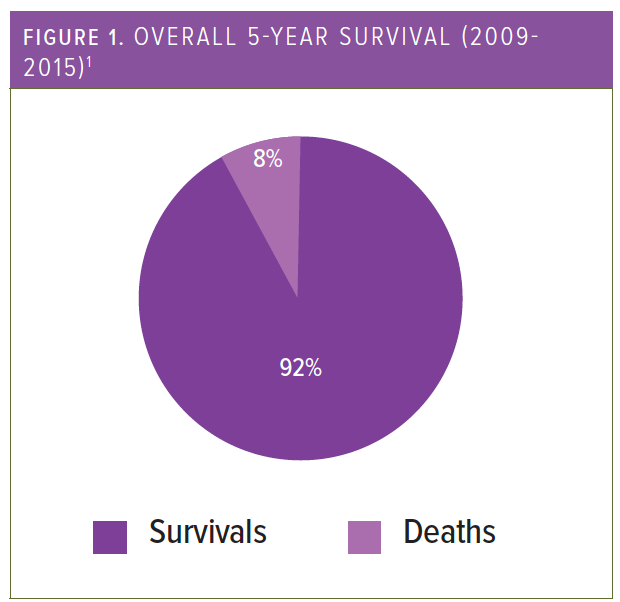
Used in combination, BRAF and MEK inhibitors are first-line therapy when the BRAF mutation is present, according to the National Comprehensive Cancer Network guidelines for
advanced melanoma.5
Systemic immunotherapy is also considered first-line therapy in the treatment of patients with advanced melanoma5 because of its significant progress in treatment outcomes6,7 and is a continuously evolving therapeutic option at the center of ongoing research. Immunotherapy, also referred to as biological therapy, harnesses the body’s natural defenses within the immune system to fight the cancer via the use of synthetic substances acting as either proteins of the immune system or signaling molecules.2 There are 4 main classifications of immunotherapy, each with diverse mechanisms of action employed to fight cancer cells (Table 2).2,3

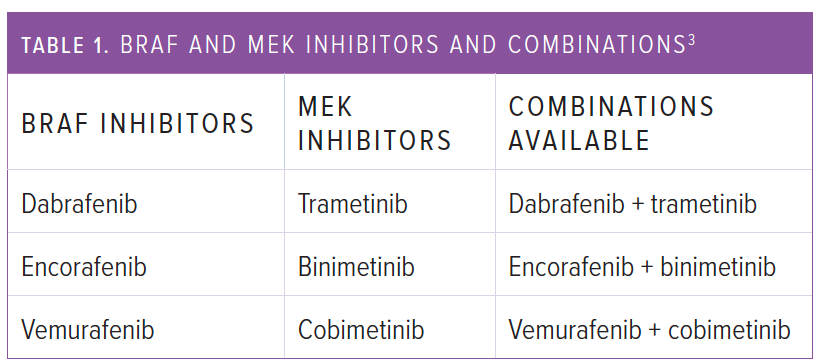
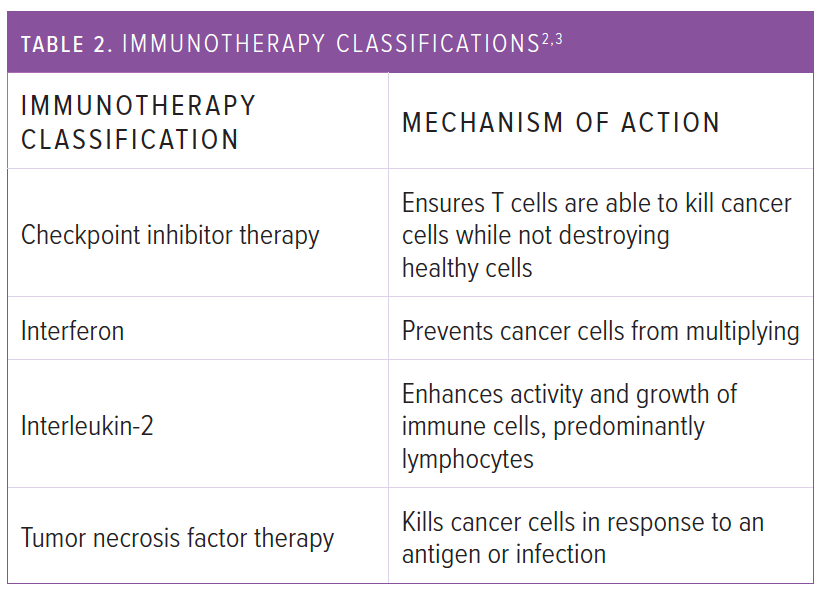
New Approaches
Over the past decade, the use of a single or combination of checkpoint inhibitors, a specific class of immunotherapy, has been at the core of numerous clinical research trials. The 2 categories of checkpoint inhibitor therapies are listed below with their specific mechanisms.2
Cytotoxic T-lymphocyte antigen 4 (CTLA-4) inhibitors block the CTLA-4 proteins from protecting cancer cells being destroyed by T cells.2,7
Programmed cell death protein 1 (PD-1) inhibitors attach to another protein, programmed death-ligand 1, to prevent PD-1 from binding and stopping T cells from killing cancer cells.2,7
Ipilimumab is a CTLA-4 inhibitor and also inhibits nivolumab and pembrolizumab PD-1.2 All of these medications are monoclonal antibodies, created by fusing human antibody-producing cells with an immortalized cell line and designed to bind to antigens in order to exert a desired effect within the immune system.8,9
In a randomized, controlled trial published in 2010, ipilimumab was compared alone and with glycoprotein 100 (gp100) versus gp100 alone.10 Gp100 is a well-studied cancer vaccine designed to decrease tumor growth.10,11 The results of this study indicated that ipilimumab, with or without gp100, led to longer overall survival in patients with metastatic melanoma compared with gp100 alone.10 The KEYNOTE-006 trial, published in 2015, then compared ipilimumab with pembrolizumab in patients with advanced melanoma. Pembrolizumab improved both progression-free survival as well as overall survival more significantly than ipilimumab and caused fewer high-grade adverse events related to toxicity.12 Later in 2015, the Check-Mate 067 trial compared nivolumab with ipilimumab alone and combined in patients with unresectable stage III or IV melanoma. The median progression-free survival for ipilimumab in combination with nivolumab was 11.5 months compared with 2.9 months with only ipilimumab only and 6.9 months for nivolumab alone.
CheckMate 067 therefore sparked interest for further research regarding combination therapy compared with monotherapy. In October 2019, the CheckMate 067 trial provided additional follow-up to the study involving ipilimumab and nivolumab. This update followed patients for a minimum of 5 years, elaborating on the 12-month follow-up from 2015. Overall 5-year survival outcomes were clearly superior in the nivolumab-containing treatment groups compared with ipilimumab alone (Figure 3).6
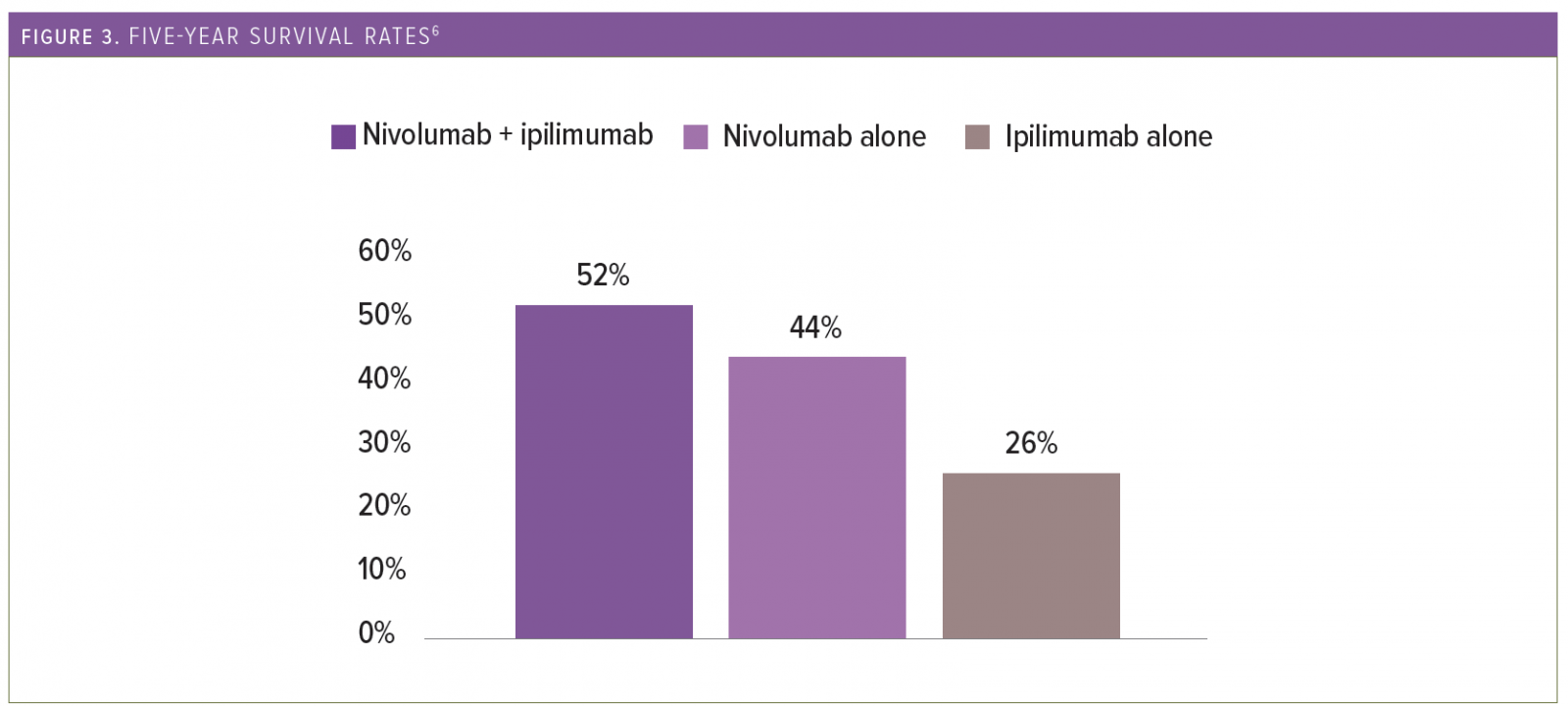
Quality of life (QOL) was measured, and the authors concluded no deterioration in health-related QOL in both groups receiving nivolumab but did note clinically meaningful decreases in QOL for the ipilimumab group.6
Conclusion
Survival rates for patients with advanced melanoma were quite dismal in the past. New advances in research and the use of immunotherapy have led to major breakthroughs
regarding biologics such as ipilimumab and nivolumab. Identification of the BRAF mutation is the first step in choosing appropriate therapy, and if present, targeted therapy should be used.5 Because of the significantly greater outcomes with combined immunotherapy, 6,12 this treatment approach should be used in patients with stage III or IV melanoma without the BRAF mutation, to optimize treatment outcomes.
REFERENCES
- National Institutes of Health. Cancer stat facts: melanoma of the skin. SEER website. http://www.seer.cancer.gov/statfacts/html/melan.html. Accessed October 16, 2019.
- National Institutes of Health. Melanoma treatment (PDQ®)—patient version. National Cancer Institute website. http://www.cancer.gov/types/skin/patient/melanoma-treatment-pdq. Accessed October 16, 2019.
- Melanoma stages. The Skin Cancer Foundation website. http://www.skincancer.org/skin-cancer-information/melanoma/the-stages-of-melanoma/. Updated April 2019. Accessed October 16, 2019.
- Melanoma skin Cancer. Cancer Research UK website. http://www.about-cancer.cancerresearchuk.org/about-cancer/melanoma?_ga=2.243338949.1767903543.1576184984-1502886992.1576184984. Updated February 12, 2016. Accessed October 17, 2019.
- Melanoma. National Comprehensive Cancer Network website. http://www.nccn.org/patients/guidelines/melanoma/files/assets/common/downloads/files/melanoma.pdf. Published 2018. Accessed October 18, 2019.
- Larkin J, Chiarion-Sileni V, Gonzalez R, et al. Five-year survival with combined nivolumab and ipilimumab in advanced melanoma. N Engl J Med. 2019;381(16):1535-1546. doi: 10.1056/NEJMoa1910836.
- Franklin C, Livingstone E, Roesch A, Schilling B, Schadendorf D. Immunotherapy in melanoma: recent advances and future directions. Eur J Surg Oncol. 2017;43(3):604-611. doi:10.1016/j.ejso.2016.07.145.
- Corthell JT. Antibodies and titrations. Basic Molecular Protocols in Neuroscience: Tips, Tricks and Pitfalls. Philadelphia, PA: Elsevier Inc; 2014:41-46.
- National Institutes of Health. Biological therapies for cancer. National Cancer Institute website. http://www.cancer.gov/about-cancer/treatment/types/immunotherapy/bio-therapies-fact-sheet. Updated April 26, 2018. Accessed October 23, 2019.
- Hodi FS, O’Day SJ, McDermott DF, et al. Improved survival with ipilimumab in patients with metastatic melanoma. N Engl J Med. 2010;363(8):711-723. doi: 10.1056/NEJMoa1003466.
- National Institutes of Health. NCI drug dictionary. National Cancer Institute website. http://www.cancer.gov/publications/dictionaries/cancer-drug/def/gp100280-288288v-peptide-vaccine. Accessed October 23, 2019.
- Robert C, Schachter J, Long G, et al. Pembrolizumab versus ipilimumab in advanced melanoma. N Engl J Med. 2015;372(26):2521-2532. doi: 10.1056/NEJMoa1503093.
